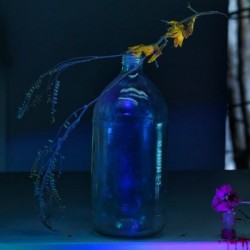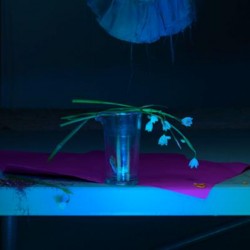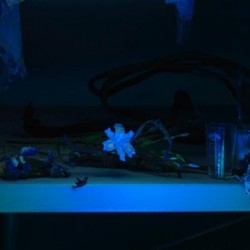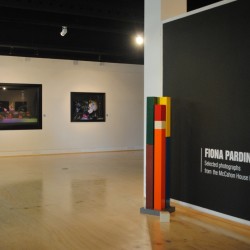Fiona Pardington
The works that photographer Fiona Pardington produced as part of her 2013 McCahon House residency possess a sparse intensity that comes from making the images very much about the location and little homages.
Pardington restricted herself to staging her still lifes on the plastic fold down tables in the studio, found objects, flowers from the McCahon family garden, water collected as rain. At the time Pardington was thinking a lot about the relationship between addiction, intoxication, and creativity – subjects that touched both her and McCahon’s life and art, and is reflected in the seeming fragility and vulnerability and relative emptiness of the photographs.
As with McCahon’s paintings, in Pardington’s hands the simplest and humblest of objects take on cosmic and transcendental meanings, but like the memento mori paintings of the Old Masters there is a hint that all things are vanity.
Dr Fiona Pardington
Fiona Pardington was born in Auckland. She is of Maori (Ngāi Tahu, Kati Mamoe and Ngāti Kahungunu) and Scottish (Clan Cameron of Erracht) descent. She holds a Masters of Fine Arts in photography from the University of Auckland. Fiona has worked as a lecturer, tutor, assessor and moderator on many photography, design and fine arts programmes at New Zealand universities and polytechnics.
Fiona’s early work is characterised by explorations in photographic technique. In the late 1980s she was amongst a group of women artists who challenged photography’s social documentary aesthetic, prevalent in the previous decade. She created photographic constructions that incorporated photography with other materials in elaborately encrusted frames. She went on to focus on the still-life format, recording Museum taonga (Māori ancestral treasures) and other historic objects such as hei tiki (greenstone pendants) and the now extinct huia bird. In these works, she brings to a contemporary audience an awareness of traditional and forgotten objects.
Fiona has received many fellowships, residencies, awards and grants including the Moet & Chandon Fellow (France) in 1991-92, the Frances Hodgkins Fellow in both 1996 and 1997, the Ngai Tahu residency at Otago Polytechnic in 2006 and an Arts Foundation Laureate Award in 2011. The Laureate Award is an investment in excellence across a range of art forms for an artist with prominence and outstanding potential for future growth. Their work is rich but their richest work still lies ahead of them. The Award recognises a moment in the artists’ career that will allow them to have their next great success.
Her work has been included in several important group exhibitions including Imposing Narratives: Beyond the Documentary in Recent New Zealand Photography, 1989, Constructed Intimacies, 1989 and NowSeeHear 1990. Prospect 2001: New Art New Zealand, all at the City Art Gallery, Wellington, Slow Release: Recent Photography from New Zealand, Heide Museum of Modern Art Melbourne, Australia and the Adam Gallery, Wellington, 2002; Te Puawai O Ngai Tahu, Christchurch Art Gallery and Pressing Flesh, Skin, Touch Intimacy, Auckland Art Gallery Toi O Tamaki in 2003 and Contemporary New Zealand Photographers, Pataka’s International Arts Festival, Porirua, 2006.
A photographer of international reputation, Pardington has exhibited widely in Australasia and in France at the Musée du Quai Branly.
In 2008 the New Zealand Government gifted a suite of her heitiki prints to the Musee du Quai Branly, Paris. A similar work auctioned in Auckland realised the highest price in New Zealand for a photographic work at auction.
Fiona returned from Paris where she completed a Laureate Artistic Creations Project with the Musee du Quai Branly in 2011. In the same year the Govett-Brewster presented The Pressure of Sunlight Falling, a series of photographs of life casts made by medical scientist and phrenologist Pierre Dumoutier during one of French explorer Jules Dumont d’Urville’s South Pacific voyages from 1837-1840. An accompanying catalogue was published by Otago University Press.
Fiona Pardington lives and works at Bayly’s Beach on the Dargaville Coast, New Zealand.
Credit: The Arts Foundation www.thearts.co.nz



